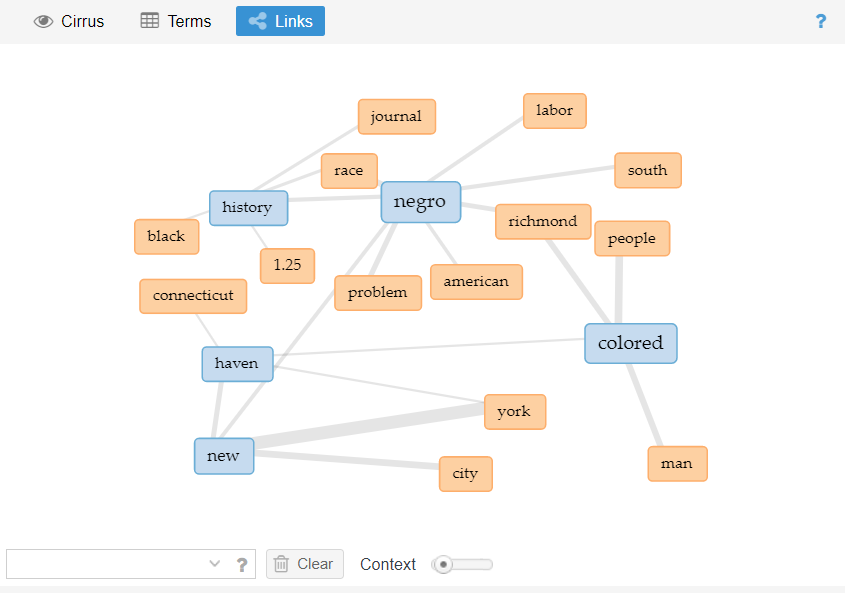After reviewing issues of The Crisis through the Modernist Journals Project, I grew interested in how the subject matter was selected for each respective issue. One main question that came to mind was whether the content included was meant to support or signify a central theme. I thought this question was relevant given the format of The Crisis being like that of a magazine, as many magazines’ plan their issues based on specific topics. That said, I also considered whether this was truly applicable since there are many differences between The Crisis and current magazines. These differences range from the social and political context (given the subject matter they may include), to more logistical constraints such as financial resources, staffing, and time.
Keeping all this in mind while exploring Voyant’s visualization tools, I was hopeful that one would be effective in identifying an issue’s theme. Of the different tools Voyant provides, I found Links to be the best option in this case as it has multiple features that provide contextual information about the most frequent words or terms present in a document. Using this tool, I decided to assess the following research question:
How does Voyant’s Links tool help visualize the theme of an issue of The Crisis?
I chose Links to visualize the theme of the Vol. 13 No. 3 of The Crisis because it provides an image of the most frequent words that appear in the issue along with the words they are most commonly associated or “linked” with. This tool provides context and insight about the issue by focusing on the most common terms and phrases that appear. If The Crisis selected content based on a single theme, then the Links tool should represent the most common words and therefore illustrate the theme.

The image above depicts the Links illustration of the analyzed issue from The Crisis. Although the tool informed me of the most common words, it was difficult to discern any particular theme as I had hoped I would be able to. While this tool can be used to support engagement in the text, and the feature of “fetching collocates” for the words that first appear does provide additional context, the level of clarity or insight about the issue’s theme is not given. However, this visualization could be used in a multi-step process that would help in determining the theme as it does list the frequency of terms and their relation to others which is still helpful information.
Ultimately, platforms like Voyant are critical in providing alternative illustrations and ways for audiences to engage in readings and for analysts to dissect and examine content. While my research question is inconclusive at best, I still support that the Links tool was the best choice for visualizing in this case. Seeing the connections between the most used key words and those keywords themselves could point to the theme of the issue, even if it is not entirely clear. In the future, a better strategy that could be used to analyze this content would be to only analyze similar content types from within an issue. Meaning, selecting only the literary pieces, like editorials or poetry, rather than also including advertisements and cartoons, may improve the utility of the Links tool. Removing this extraneous content which may not support the theme of the issue would change the visualization in such a way that the theme may become more apparent and provide insight to Voyant users.
It was interesting that with certain sentences you analyzed the magazine called the crisis and found and organized research questions related to it.
Like your research questions, I am also interested in and focused on data visualization, so I look forward to the creation of tools to visualize data with more advanced technology in the future.
But I think we should not only be predicting the future, but also make better visualization tools developed by our generation.
(leejae44)
I enjoyed the type of tool you decided to use due to the fact that it was something I had not yet interpreted before. However, the picture provided, helped explain a lot of your situation on how it does provide the use of common words, but would be a multistep process for having to find the theme. Overall though, the use of the visualization does help when looking for clarity and the use of tools that Voyant has helps tremendously.
Abby,
I love how you went straight into an important question and started to formulize connections between each idea. “The Crisis” is indeed similar to a magazine, which changes the way we look at this information, and your usage of visual and analytical data as well as reasoning definitely pulled this all together!